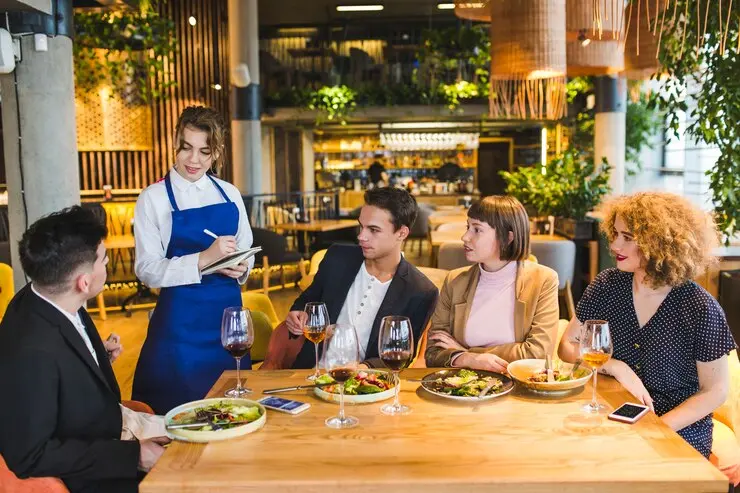Blog
Top 10 Restaurant Trends to Look Out For In 2025

The restaurant industry continues to progress, introducing new methods for guests to dine out and engage with restaurants. From AI-powered service tools to the enthusiasm for more unique experiences, riding the fore-horse signifies adjusting your service to satisfy these shifts head-on. Having the right knowledge helps you produce great moments for diners and boost your business.
My friends, in this blog we will shed light on 10 restaurant trends for 2025.
So, above anything else, let's start the topic.
Group Dining Makes a Comeback
Group dining is observing growth and is a trend anticipated to continue in 2025. Data shows a 13% growth in dining for parties of six or more, Year Over Year. It's beyond doubt that there is an updated appetite for social connection and celebration. Think booking for parties of six or more, at any point of the day.
For restaurants, group dining is a move that introduces opportunities to make dedicated group offerings and adapt your service structures to serve larger parties. Think about how your place can be versatile and adjust to various group sizes and dining types while keeping the standard of experience for all guests.
Mid-Week Dining Gains Momentum
In what might be regarded as an unanticipated shift, midweek has appeared as a famous time to dine out for some individuals, following the research. Data represents a 10% growth in seated dinners on Wednesdays - the longest jump contrasted to any other day of the week, Year Over Year. Flexible work schedules are possibly directing the trend, with people being more encouraged to extend their restaurant visits apart from regular peak times.
Restaurants observing the most success with mid-week services are the ones making particular draws for these days. Make specials, events or tasting menus that make guests to dine during customarily slower periods.
AI Moves Past the Hype
AI has evolved from an interest to a functional tool and can notably strengthen many particulars of the restaurant sector. AI-driven systems are helping restaurants simplify inventory management, minimize food waste, and improve staff scheduling.
Moreover, AI-powered chatbots and voice assistants produce customized customer interactions, while forward-looking analytics advise menu development and marketing strategies. These improvements will aid your restaurant's function more productively and satisfy growing customer hopes.
Contactless Payments Become Standard Practice
The switch toward contactless ordering and payments keeps going, with projections indicating that around 80% of restaurant transactions will be non-cash by 2025. Comfort is one characteristic guiding this trend, but it's also an acknowledgment of the requirements to satisfy advancing guest expectations and give them smooth, efficient service.
Digital wallets and QR codes are also becoming regular specifications of the dining experience. They might not certainly be the latest trends, but restaurants should look at ways to implement these technologies while maintaining the personal feel that determines excellent hospitality.
Simplified Menus Encourage Repeat Guests
Determined by both operational excellence and guest tastes and preferences for value over volume, the trend toward uncomplicated menus goes on to gain momentum. A well-structured menu enables better execution and provides obvious choices for guests. It can also help with minimizing food waste.
Many food places are now serving fewer dishes, but doing them amazingly well in place of maintaining long menus of food items. This approach not only enhances consistency but time and again generates excellent guest satisfaction and more efficient kitchen operations.
Restaurant Mergers and Acquisitions Expected to Rise
Experts anticipate a growth in restaurant mergers and acquisitions (M&A) in 2025, accelerated by lower interest rates and escalated capital availability. Private equity firms, hedge funds, and lenders are planning to invest, mainly as restaurant brands such as Cava and Sweetgreen continue to do well. Franchisees are anticipated to leverage access to debt to expand their territories with non-competing brands. Many operators, having built their presence with one brand, are searching for opportunities in brands with favourable growth potential.
However, industry professionals caution that possessors, private equity firms, and investors will stay selective in their approach. While smaller transactions, like franchisees possessing other franchisees or tuck-in deals with brands, are possibly to increase, a notable boost in M&A activity is not anticipated. Selectivity will play an important role in forming the market's way in the coming years.
Consumer Demand is Expected to Increase
Even with elevated restaurant prices in 2024, consumer demand remains tough, with year-over-year spending on the rise. Experts say that if wages continue to grow consumer-facing sectors are will-placed to manage increased demand. According to reports, consumers are spending freely, and unless there's a big shift in the economy, this trend is possible to remain.
However, consumers are becoming more choosy in their purchasing decisions, mainly regarding dining out. Igram pointed out that while spending may be up, frequency and occasion-based choices are more calculated. Even with concerns over growing prices, consumers still give priority to fresh, excellent-quality food and are willing to pay a premium for it.
Fast Casual Remains the Leading Segment
Fast casual remains a dominant segment in 2024, with brands like Wingstop, Chipotle, and Shake Shack showing the way. This sector surpassed quick-service and casual dining chains, determined by consumers shifting from casual dining and searching for better food experiences. Brands that provide extravagant, excellent-quality experiences are observing good sales, following Rowe.
Consumers are progressively drawn to piquant flavours and healthier choices, which fast-casual brands offer. Renowned choices like Cava's Mediterranean menu and Chipotle's Mexican bowls serve these preferences. Potbelly combines one-to-one service with convenience, providing a balance of human interaction without the wait typical of casual dining.
The Focus on Sustainability
Sustainability is becoming of prime importance in the restaurant industry as consumers grow more aware of their environmental impact. As a result, many restaurants are adopting eco-friendly practices like:
● Plant-based menu
● Zero-waste strategies
● Sourcing ingredients locally
These changes not only serve the growing demand for sustainable choices but also help minimize the carbon footprint connected with food production.
As sustainability carries on with shaping dining trends, it provides restaurants an opportunity to enhance their brand image. By aligning with environmentally responsible values, establishments can attract eco-conscious diners and get into the position of frontrunners in the growing food industry.
The Rise of Plant-Based Options
As more individuals opt for plant-based diets for health, ethical, or environmental reasons, the demand for artistic plant-based dishes continues to rise. As a result, restaurants are expanding their vegetarian and vegan offerings, making certain these menus are diverse, flavorful, and tempting to a wide range of diners.
This shift toward plant-based eating is not entirely a trend but an elemental change in how we approach food. With a rising significance on sustainability and wellness, plant-based choices are anticipated to remain central to restaurant menus in the coming years, reforming dining experiences and catering to the changing preferences of contemporary consumers.
Real-World Example: JKS Restaurants' Growth As Its Turnover Tops £73m
JKS Restaurants, with locations in the UK and Middle East, reported a turnover of £73.7 million for the 65-week period ending 31 March 2024, reflecting significant growth. Despite a loss before tax of £5.1 million, the group achieved an EBITDA profit of £8.6 million. Their expansion includes a £3 million investment into Gymkhana Fine Foods and the introduction of new concepts like Ambassador's Clubhouse and a BAO outpost in the City of London.
JKS' growth aligns with key restaurant trends, including the demand for unique dining experiences. Ambassador's Clubhouse taps into this with its immersive atmosphere and family-inspired menu. Their ability to adapt to trends like mid-week dining and sustainability, with plant-based options and high-quality offerings, demonstrates how successful operators are responding to evolving consumer preferences.
JKS' strategy emphasizes diversification, distinctive experiences, and staying ahead of trends, offering valuable lessons for restaurants aiming to remain competitive in 2025.
Maximizing Opportunities with the Latest Dining Trends - Final Words
Restaurants can achieve great success in 2025 by understanding which trends are applicable to their strategy and incorporating them in ways that improve in place of divert from their fundamental offering. No matter, whether you're introducing a new menu, adopting AI, or making unique mid-week experiences, every change should support your mission of delivering excellent hospitality.
In essence, every triumphant trend adaption is the changeless objective of making guests feel respected and excited to return. Keep this in mind as you go through the thrilling changes in 2025.
We at Peepal UK hope this complete guide to the top restaurant trends for 2025 has provided you with valuable insights to help steer the changing sphere of the industry. We trust that the information shared will inspire and guide you as you prepare to implement these trends in your business.

